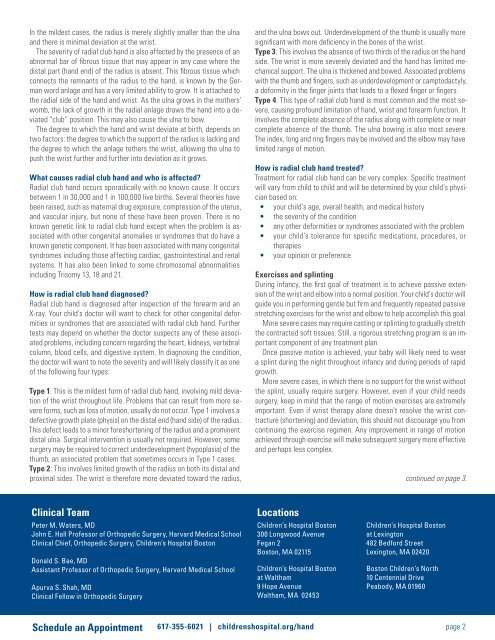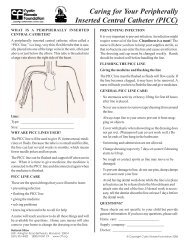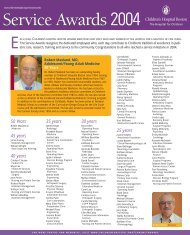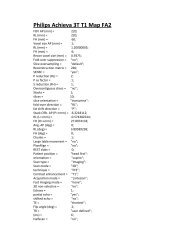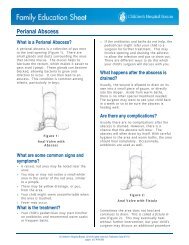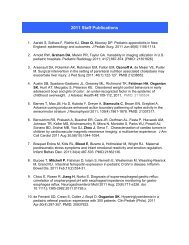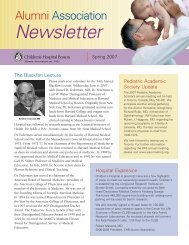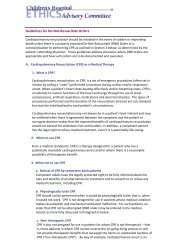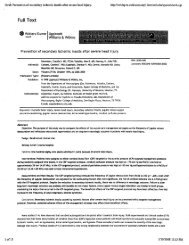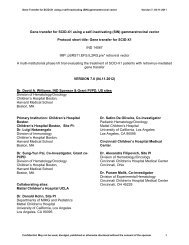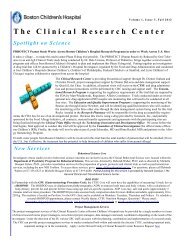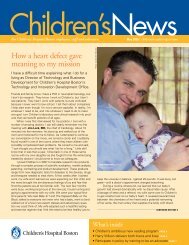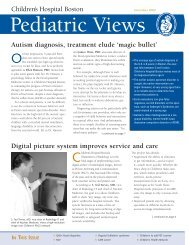Radial Club Hand - Children's Hospital Boston
Radial Club Hand - Children's Hospital Boston
Radial Club Hand - Children's Hospital Boston
You also want an ePaper? Increase the reach of your titles
YUMPU automatically turns print PDFs into web optimized ePapers that Google loves.
In the mildest cases, the radius is merely slightly smaller than the ulna<br />
and there is minimal deviation at the wrist.<br />
The severity of radial club hand is also affected by the presence of an<br />
abnormal bar of fibrous tissue that may appear in any case where the<br />
distal part (hand end) of the radius is absent. This fibrous tissue which<br />
connects the remnants of the radius to the hand, is known by the German<br />
word anlage and has a very limited ability to grow. It is attached to<br />
the radial side of the hand and wrist. As the ulna grows in the mothers’<br />
womb, the lack of growth in the radial anlage draws the hand into a deviated<br />
“club” position. This may also cause the ulna to bow.<br />
The degree to which the hand and wrist deviate at birth, depends on<br />
two factors: the degree to which the support of the radius is lacking and<br />
the degree to which the anlage tethers the wrist, allowing the ulna to<br />
push the wrist further and further into deviation as it grows.<br />
What causes radial club hand and who is affected?<br />
<strong>Radial</strong> club hand occurs sporadically with no known cause. It occurs<br />
between 1 in 30,000 and 1 in 100,000 live births. Several theories have<br />
been raised, such as maternal drug exposure, compression of the uterus,<br />
and vascular injury, but none of these have been proven. There is no<br />
known genetic link to radial club hand except when the problem is associated<br />
with other congenital anomalies or syndromes that do have a<br />
known genetic component. It has been associated with many congenital<br />
syndromes including those affecting cardiac, gastrointestinal and renal<br />
systems. It has also been linked to some chromosomal abnormalities<br />
including Trisomy 13, 18 and 21.<br />
How is radial club hand diagnosed?<br />
<strong>Radial</strong> club hand is diagnosed after inspection of the forearm and an<br />
X-ray. Your child’s doctor will want to check for other congenital deformities<br />
or syndromes that are associated with radial club hand. Further<br />
tests may depend on whether the doctor suspects any of these associated<br />
problems, including concern regarding the heart, kidneys, vertebral<br />
column, blood cells, and digestive system. In diagnosing the condition,<br />
the doctor will want to note the severity and will likely classify it as one<br />
of the following four types:<br />
Type 1: This is the mildest form of radial club hand, involving mild deviation<br />
of the wrist throughout life. Problems that can result from more severe<br />
forms, such as loss of motion, usually do not occur. Type 1 involves a<br />
defective growth plate (physis) on the distal end (hand side) of the radius.<br />
This defect leads to a minor foreshortening of the radius and a prominent<br />
distal ulna. Surgical intervention is usually not required. However, some<br />
surgery may be required to correct underdevelopment (hypoplasia) of the<br />
thumb, an associated problem that sometimes occurs in Type 1 cases.<br />
Type 2: This involves limited growth of the radius on both its distal and<br />
proximal sides. The wrist is therefore more deviated toward the radius,<br />
Clinical Team<br />
Peter M. Waters, MD<br />
John E. Hall Professor of Orthopedic Surgery, Harvard Medical School<br />
Clinical Chief, Orthopedic Surgery, Children’s <strong>Hospital</strong> <strong>Boston</strong><br />
Donald S. Bae, MD<br />
Assistant Professor of Orthopedic Surgery, Harvard Medical School<br />
Apurva S. Shah, MD<br />
Clinical Fellow in Orthopedic Surgery<br />
and the ulna bows out. Underdevelopment of the thumb is usually more<br />
significant with more deficiency in the bones of the wrist.<br />
Type 3: This involves the absence of two thirds of the radius on the hand<br />
side. The wrist is more severely deviated and the hand has limited mechanical<br />
support. The ulna is thickened and bowed. Associated problems<br />
with the thumb and fingers, such as underdevelopment or camptodactyly,<br />
a deformity in the finger joints that leads to a flexed finger or fingers.<br />
Type 4: This type of radial club hand is most common and the most severe,<br />
causing profound limitation of hand, wrist and forearm function. It<br />
involves the complete absence of the radius along with complete or near<br />
complete absence of the thumb. The ulna bowing is also most severe.<br />
The index, long and ring fingers may be involved and the elbow may have<br />
limited range of motion.<br />
How is radial club hand treated?<br />
Treatment for radial club hand can be very complex. Specific treatment<br />
will vary from child to child and will be determined by your child’s physician<br />
based on:<br />
• your child’s age, overall health, and medical history<br />
• the severity of the condition<br />
• any other deformities or syndromes associated with the problem<br />
• your child’s tolerance for specific medications, procedures, or<br />
therapies<br />
• your opinion or preference<br />
Exercises and splinting<br />
During infancy, the first goal of treatment is to achieve passive extension<br />
of the wrist and elbow into a normal position. Your child’s doctor will<br />
guide you in performing gentle but firm and frequently repeated passive<br />
stretching exercises for the wrist and elbow to help accomplish this goal.<br />
More severe cases may require casting or splinting to gradually stretch<br />
the contracted soft tissues. Still, a rigorous stretching program is an important<br />
component of any treatment plan.<br />
Once passive motion is achieved, your baby will likely need to wear<br />
a splint during the night throughout infancy and during periods of rapid<br />
growth.<br />
More severe cases, in which there is no support for the wrist without<br />
the splint, usually require surgery. However, even if your child needs<br />
surgery, keep in mind that the range of motion exercises are extremely<br />
important. Even if wrist therapy alone doesn’t resolve the wrist contracture<br />
(shortening) and deviation, this should not discourage you from<br />
continuing the exercise regimen. Any improvement in range of motion<br />
achieved through exercise will make subsequent surgery more effective<br />
and perhaps less complex.<br />
Locations<br />
Children’s <strong>Hospital</strong> <strong>Boston</strong><br />
300 Longwood Avenue<br />
Fegan 2<br />
<strong>Boston</strong>, MA 02115<br />
Children’s <strong>Hospital</strong> <strong>Boston</strong><br />
at Waltham<br />
9 Hope Avenue<br />
Waltham, MA 02453<br />
continued on page 3.<br />
Children’s <strong>Hospital</strong> <strong>Boston</strong><br />
at Lexington<br />
482 Bedford Street<br />
Lexington, MA 02420<br />
<strong>Boston</strong> Children’s North<br />
10 Centennial Drive<br />
Peabody, MA 01960<br />
Schedule an Appointment 617-355-6021 | childrenshospital.org/hand page 2


